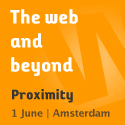Richard Anderson, member of the executive council of UXnet, writes on
his blog:
I am a good example of "the glue" that most companies need, and I have the advantage of being very good at making it possible for people to express themselves effectively.
For Richard, being "the glue" means to bring the worlds of design, business, and engineering closer together. According to him it helps if designers, business people and engineers express themselves effectively.
So I wondered:
As a designer, does expressing yourself effectively help you come closer to business and engineering? I think the answer is "Yes" and I think that the key is in the word effectively. Here is a short list of what can go wrong:
- if you have no audience, your words have no effect;
- if you can not express yourself in the right terms, your words have no effect
- if you express yourself but it takes very, very long, say a couple of sentences, or maybe even one really longwinded sentence, with a couple of side-sentences within it, so, really, really long, before you get to the core of the message, you will have lost your audience, and your words have no effect (hello?)
- if you express yourself, but your audience is busy, you wil have no effect
- if you express yourself, but your message is not acted upon, you have no effect
To counter all that, here's a list of ways to communicate effectively:
- market: make sure you are heard by your audience
- express: find a vocabulary for what you do
- limit: tell your audience one thing at a time
- time: plan your message to have the most effect
- follow up: speak in actionable terms and help your audience act
If you want to influence the position of design in your company, it is time to start practicing melt-fu.
melt-fu: the act of communication with the intention of glueing together the design, business and engineering worlds
Market Yourself: If you have something to say, say it. Pick the right people to talk to, people who could use a little help in learning what you do, and preferably people you work with or whom you deliver to. New employees on a tour of the company on their first day are a great place to start. Don't be afraid to blow your own horn. Shout if you have to.
Express Yourself(hey, hey, hey, hey): Pick your words carefully and develop your own controlled vocabulary of words that you and your design peers use consistently when you refer to your artefacts, your processes, your tools and methods. Is your wireframe a wireframe, a wire frame, a blueprint, or a schematic? Is your sketch a moodboard, a visual study, an early mockup, or a treatment? Is your usability test strategy just that and does it develop into usability test plans, reports and recommendations, or will you call it market research, consumer research, customer listening, people centered design, user-centered design, or user experience design? Is the first phase of your projects called planning, analysis, requirements gathering, inception, or assessment?
Limit yourself: Chunk your message into manageable, easily digestible parts. You may be able to oversee the bigger picture and all the details, but your audience probably does not. Start at the top, with a high level overview of your message, if your audience is analytic (engineers!). Our designer peers seem to want to hear stories from the inside out: start with a few details, through deliverables or examples, and gradually work your way into the conceptual aspects of your story; your methodology or co-operation philosophy. I know from experience that business types prefer a short story about one aspect, short enough that they can memorize it and tell their friends, your clients.
Time yourself: Deliver your message when it has effect. Introduce a new naming convention for your deliverables at the start of a new project, so that it gets included in all the documentation from project plan to
post-mortem evaluation
(I hate that term, it's like the project died, but is commonly used, e.g. here). Tell the high-level story to the new marketing director when he comes over to meet the designers. Make the story part of the introduction program for new employees. Or mention it as a way to save money when next year's budgets are discussed, because your new way of doing things reduces risks and increases the chances of an early delivery.
Follow Up on yourself: Make sure there is a place where your audience can read (parts of) your story after you told them about it. Provide quick-reference cards for business types and designers, process models that match with software engineering models, and extensive background documentation for those that will have to act upon your story. Oh, and
repeat yourself.
That is how you make sure your story sticks, with designers, business types and engineers. It is through melt-fu that your story becomes the true glue.
Update: changed the title today (Dec 15), it was a bit too cryptic.






